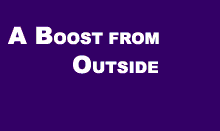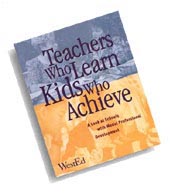 These schools are a triumph of the human spirit. Mostly, they succeed through their own caring and persistence. But they also benefit from help outside the school in two significant areas: pressure and support. EXTERNAL CALL TO ACTIONIt can be hard to step back from familiar routines and realize that business as usual is just not enough. Each of the eight schools in this study was spurred into greater action by a force outside of itself. In some schools, low enrollment that threatened closure was the wake-up call. For others, the appearance in local newspapers of students’ state test scores sent a very public message about the school’s performance. As a Wilson Elementary teacher put it, "When the state tests started to appear, that really got our attention. We’re up to snuff now. That has been driving a lot of changes here." In some cases, a new principal brought higher expectations and a plan for reform. And in some of these schools a university partnership initiated a review of student performance that told a disturbing story. External accountability measures hold schools responsible for meeting set performance standards for all students. In a number of model schools, these measures have caused teachers to think differently about students’ capabilities. This is especially true for those teaching students with special needs. These students now have more opportunities for learning because they are fully included in the classrooms or receive instruction that accommodates their needs. Their performance is now studied in light of the performance of other students. Other children who learn differently also benefit from public accountability measures. Teachers at these award-winning schools understand the unique needs of their students and are motivated to devise and adapt strategies to address them. In the words of one Mason teacher, "Now I can teach any student you give me." What is striking about the teachers at these sites is that they accept responsibility for their students’ results rather than make excuses for the results. This is a fundamental step in making change at any school. PARTNERSHIPS WITH EXTERNAL PROGRAMSChange really is hard. Partnerships with local universities, research-based programs, and reform networks can provide moral support, as well as material help. In these award-winning schools, help was available in some form of powerful partnership. Ganado Intermediate, for example, has several local colleges and universities as partners. University faculty members teach on-site classes, visit the school, and serve as coaches. As a member of the rural schools network of the Bread Loaf School of English at Middlebury College in Vermont and the Northern Arizona Writing Project, Ganado has opportunities to receive training and send teachers to conferences and summer institutes. The school also participates in a Spencer Foundation grant to promote action research among rural teachers. H.D. Hilley is a part of the Urban Systemic Initiative (USI) in its school district. The USI provides mentors to coach teachers and offers a number of workshops and training sessions for teachers in math and science. A long-term association with the University of Texas at El Paso provides research, support, and guidance about change. Several teachers at H.D. Hilley commented that their association with the university provided the fuel for change. International High School is a member of the Annenberg New York Network for School Renewal. The collaborative gives staff members access to resources and support from other schools in the network. Several other international high schools in the New York City district are modeled after International and create a network for collaboration and inservice of teachers working with similar students and curriculum. Samuel E. Mason Elementary maintains a number of supportive alliances. Their partnership with the John Hancock Corporation led to training in quality management in the early stages of their reform efforts. They also have partnerships with the Accelerated Schools network and City Year Youth Team, a group of young adults who help in the school. Several local colleges and universities provide other resources and expertise, from placing preservice teachers at Mason to supporting the implementation of literacy and math programs with courses and coaches. Hungerford is part of Project Arts, a community program to bring theater and dance opportunities into the school. A few teachers, through their personal association with community groups, bring additional resources into the school to enhance their curricular areas. Teachers also tap community-based service providers to seek extra assistance and support for their special needs students. Across the set of eight schools, teaming up with local university and college faculty brings a variety of course offerings, adds support teachers, and introduces current research and information about teaching and content areas. Associations with local businesses and national networks offer these schools new perspectives, a wealth of new ideas, and access to new information. Each partnership provides expertise and access to additional opportunities for learning. FISCAL RESOURCESThe partnerships mentioned above bring significant resources to the school: people, ideas, and concrete assistance. There’s no question but that it costs money to provide people’s time or material goods, or that developing and implementing ideas is expensive. Some of these partnerships are supported through state, federal, or foundation grants. Hilley, for example, benefits from mentor teachers provided via an Urban Systemic Initiative grant to the district from the National Science Foundation. These schools draw from a wide range of funding sources for other aspects of their programs as well. They volunteer for opportunities that come up through the state or district. They seek out grants. Teachers at Hungerford wrote grants for school-based management and later sought funds to expand their innovative hydroponics unit into a three-school Web site. Several schools have technology grants. Guided by their goals for students and their improvement plans, they are creative in locating funds to pursue their goals. But not all they do requires extensive outside funding. Some school-university partnerships are supported by the reallocation, through joint planning, of existing institutional resources of each partner – rethinking roles and relationships, not necessarily finding more money. Taking advantage of its location on the LaGuardia Community College campus, International High School shares more than facilities and resources with the college. College and high school faculty exchange some teaching assignments, and college faculty participate with the interdisciplinary teams to align high school instruction with college entry requirements. Several of the schools arrange with local universities to host their preservice teachers, thereby expanding their professional learning community. Targeted school and district resources play their part, too. Schools have funds set aside to support teachers’ attendance at off-site conferences and workshops, and although the processes for requesting these funds may differ from school to school, most teachers know that their requests are welcome if they align with school goals or their individual professional development plans. Principals and school leadership teams see that their role is to ensure adequate funding and to creatively allocate the budget to support teacher learning. See also: External Programs |

|
WestEd
WestEd Home | Search | Feedback
About WestEd | Our Work | Resources | What's New
This information can be found at
http://
Last modified
©
WestEd® | (415) 565-3000 | www.WestEd.org